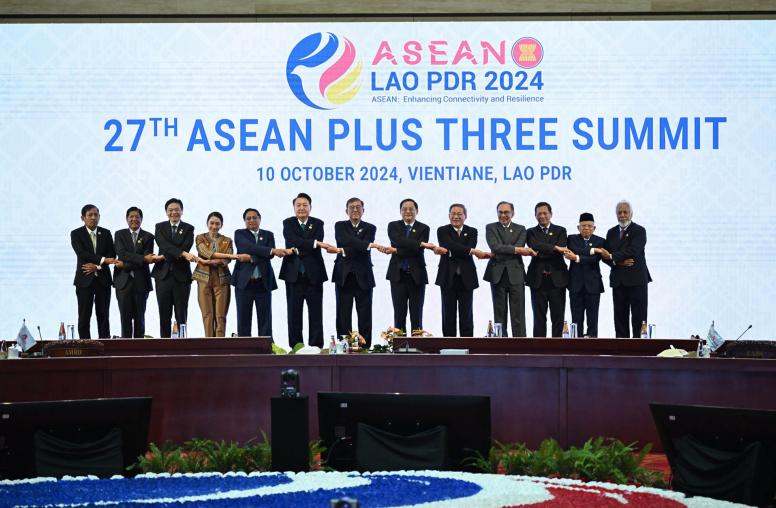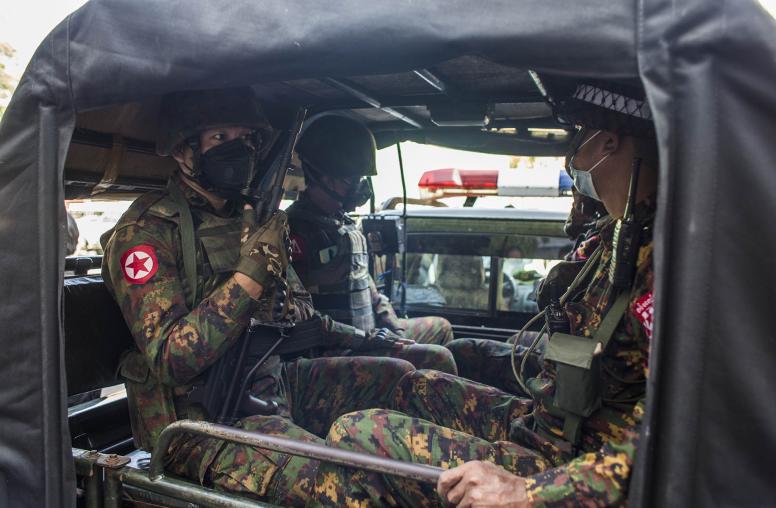China’s Role in Myanmar’s Internal Conflicts
This report is the first in the Senior Study Groups (SSGs) series that USIP is convening to examine China's influence on conflict dynamics around the world. A group of thirteen experts met from February to June 2018 to assess China’s involvement in Myanmar’s internal conflicts, particularly those in Rakhine, Kachin, and Shan states, as well as China’s impact on Myanmar’s overall peace process. This report draws in part on previous research commissioned and published by USIP, including China and Myanmar’s Peace Process, by Yun Sun; Understanding China’s Response to the Rakhine Crisis, by Adrienne Joy; Burma’s Northern Shan State and Prospects for Peace, by David Scott Mathieson; and Reframing the Crisis in Myanmar’s Rakhine State, by Gabrielle Aron. Unless otherwise sourced, all observations and conclusions are those of SSG members or of expert guests at SSG meetings.
Executive Summary
Since gaining its independence from British colonial rule in 1948, Myanmar (also known as Burma) has faced ethnic division and conflict. For decades, an array of ethnic political movements and their armed wings have sought political, economic, cultural, and social rights as protection against domination by (majority) Burman authorities, even as the Myanmar military (the Tatmadaw) has asserted that its mission is to ensure the country’s sovereign independence, territorial integrity, and unity. Majority-minority ethnic relations and the distribution of power and resources have been the most serious problems since independence. Achieving mutual trust and a system of governance agreeable to all of Myanmar’s diverse peoples are the country’s defining challenges.
In northern Myanmar near the Chinese border, fighting between the Tatmadaw and ethnic armed groups has increased despite efforts to advance a comprehensive peace process that gained momentum under the Thein Sein government beginning in 2011. A Nationwide Ceasefire Agreement (NCA) was signed by eight groups in October 2015, but most of the larger groups abstained, including those along Myanmar’s border with China. Under the National League for Democracy (NLD), led by State Counselor Aung San Suu Kyi, progress has been slow: the peace process has stalled, confidence in it has fallen, and violence has increased, particularly in Kachin and northern Shan states along the Chinese border. Divisions between NCA signatories and nonsignatories have grown, the divide roughly corresponding to whether a group is located on the India or Thai border (signatories) or China border (nonsignatories). Several nonsignatory groups formed the Northern Alliance to strengthen their military and political power.
Driven by security concerns, economic interests, and a desire for political influence in a country with which it shares a 1,500-mile border, China is playing a key role in Myanmar’s internal security and peace process. Armed clashes between Myanmar’s military and ethnic armed groups along the Myanmar-China border occasionally spill into China. The Chinese province of Yunnan has sheltered tens of thousands of refugees during periods of intense fighting in Myanmar. In 2013, China designated a special envoy, selected from among its most seasoned diplomats, to serve as lead point of contact and formal observer to Myanmar’s peace talks. This envoy, who changed in 2015, remains an important player in facilitating talks between the ethnic armed organizations (EAOs) and the Myanmar government.
China has also come to the defense of the Myanmar government over the crisis in Rakhine State to the west, where the Tatmadaw has carried out a brutal campaign of ethnic cleansing, if not genocide, against the mostly Muslim Rohingya population. China has protected Myanmar from sanctions at the United Nations and has offered rhetorical and material support for its handling of the so-called terrorist attacks. Furthermore, China has extensive economic interests in Rakhine, including a major port at Kyaukphyu, a planned special economic zone (SEZ), and a road, rail, and pipeline network to move energy and other materials and supplies from the Bay of Bengal through Myanmar to Yunnan Province.
For its part, the United States has long supported Myanmar’s reform process but has had a limited role in the peace process. This is in part—though by no means entirely—due to China’s explicit opposition to US engagement, particularly in areas along the Chinese border, and general concern about US influence in Myanmar. Myanmar will serve as the ultimate arbiter of any US involvement in its affairs. Nonetheless, assessing China’s role in and perspectives toward Myanmar’s internal conflicts may offer important insights into overall conflict dynamics inside the country and help inform potential US peace-support policies going forward.
Observations
China has set aside its stated adherence to the principle of noninterference to become more proactively and assertively involved in Myanmar’s peace process. It has made efforts to be directly involved in the primary conflict issues Myanmar faces and has sought to shape the decisions and choices of Myanmar’s various players. It has offered itself as a mediator in the conflict and pressured nonsignatory groups along its border to attend successive Union-level dialogues in Naypyidaw. As indicated, it has sought to limit the involvement of third countries (including the United States) in the peace process, despite the desire of several Myanmar groups for broader international engagement. In response to the Rohingya crisis, China has proposed principles and a process for resolution, and offered, unsuccessfully, to mediate between Myanmar and Bangladesh to resolve their disputes.
Myanmar considers China’s engagement to be constructive overall. Both government-affiliated and unofficial interlocutors, including those from ethnic groups, commented that China’s involvement in peace has not been unduly obstructive or harmful to the process to date. They note that Myanmar’s government has alternately resisted and welcomed China’s involvement as long as China helps promote Naypyidaw’s goals. Ethnic groups have responded similarly, although those along the border have few options but to accede to Chinese pressure.
Myanmar harbors questions about China’s ultimate motives, however. Myanmar observers have remarked that China ultimately benefits from neither hot war nor complete peace. Beijing seeks a reduction of fighting along its border to safeguard stability, maintain cross-border economic ties, and mitigate refugee flows. Cessation of fighting more broadly, including in Rakhine State, allows for its investments to proceed unobstructed, including strategic infrastructure projects linking Myanmar—and the Indian Ocean—to China under its Belt and Road Initiative and China-Myanmar Economic Corridor.
At the same time, genuine peace risks China’s strategic position in the country. Continued friction between central authorities and border populations provides Beijing a major source of influence over Naypyidaw. That leverage may be used, among other things, to prevent “unwelcome” influence of the United States in the country and thus the region. Genuine sustained peace also would weaken China’s influence over ethnic nationalities, particularly along the border. That includes the Wa people, who speak Chinese, trade in Chinese currency, and receive substantial support from China to maintain the thirty-thousand-person Wa army and political autonomy. Because China does not expect that real peace is possible for the foreseeable future, it calculates little cost to its generally constructive, if interested, role in Myanmar’s peace process.
China has demonstrated little interest in coordinating peace-support efforts with others. Successive Myanmar governments have sought to ensure the international community is coordinated in its support of the peace process. Ethnic groups have likewise sought united support for the goal of peace with justice. Although many mechanisms have been established to ensure such coordination, China has been notably absent from them. Beijing worked side by side with the United Nations as an official observer of the process under the Thein Sein government, but since 2012 has continued to operate independently—and opaquely—to help Myanmar address its internal challenges.
The Rohingya crisis has provided China an opportunity to reestablish its primacy among Myanmar’s foreign relationships, attract popular support in Myanmar, and assert its leadership in regional affairs. As Naypyidaw’s handling of the Rohingya crisis has strained its relations with the United States and other Western countries, China has buffered Myanmar from international pressure and taken steps to protect Myanmar from criticism and punitive actions in the United Nations Security Council. Beijing seeks to use its pro-government position on the Rohingya issue to win Naypyidaw’s support for China’s political and economic interests throughout the country, including development of the Kyaukphyu port and SEZ in Rakhine State.
Private actors within China and outside official control also contribute to conflict, including illicit cross-border trade and mercenary services. Largely illicit Chinese entities that traffic in Myanmar’s natural resources often act in concert with corrupt officials in the Myanmar government, military, and EAOs to fuel conflict in Kachin and Shan states. As a result, Chinese business actors provide revenue to conflict actors on both sides and help sustain Myanmar’s civil war. Chinese citizens, including retired People’s Liberation Army (PLA) soldiers, have reportedly sold their services as mercenaries for EAOs. There is no indication that officials in Beijing support, let alone sponsor, such activity.
China has strengthened central direction over Myanmar policy in the past decade, ensuring improved coordination and control of the diplomatic, military, and economic aspects of its relationship with Myanmar. In the past, Yunnan actors have tried to exploit vague central government directives on cross-border activity. However, Beijing has put Yunnan provincial authorities on a tighter leash, largely in response to crises along the border. It has also reduced the space previously accorded Yunnan’s provincial leadership in the Sino-Burmese relationship.
Even as Beijing strengthens ties with Myanmar’s government and military, a number of domestic factors will continue to constrain Chinese influence in the country. Myanmar, like other countries in Southeast Asia, seeks to avoid overreliance on any single country and to maintain a balance of power among large countries to enable it to maximize its leverage and defend against undue external influence in its affairs. Myanmar particularly worries about Chinese influence because of China’s size, power, and proximity, as well as the way China’s economic development projects have been carried out without due consideration for the well-being of Myanmar’s population and ecology. At the same time, Myanmar admires China’s rapid economic development, wants to benefit from Chinese trade and investment, and recognizes that geography is destiny and thus Myanmar must maintain a constructive relationship with its neighbor to secure its own long-term stability and development.
Recommendations
The United States should continue to support the complete and timely implementation of the recommendations of the Advisory Commission on Rakhine State (the “Annan Commission”) report in 2017. Among other things, the report’s recommendations called for citizenship verification, freedom of movement, and access to livelihoods for the Rohingya, and socioeconomic border security and socioeconomic development more broadly in Rakhine State. In the process, the US government should consider ways to both apply pressure and appropriately engage the Myanmar military in a way that empowers democratic institutions in Myanmar, moves toward resolution of the Rakhine crisis, and continues the progress of reform inside the country.
The US government should seek more open dialogue with Beijing about respective peace-support activities to avoid attitudes that could complicate an already difficult peace process and resolution of the Rakhine crisis.
At the same time, the United States should encourage China to support implementation of the recommendations of the Advisory Commission, and to participate in broader international aid coordination initiatives related to the peace process and Rakhine State to maximize efficiency and improve effectiveness. That would require China to avoid viewing the United States and other nations’ engagement in Myanmar in zero-sum terms.
The US government should also encourage Beijing to be more transparent about its peace strategy and engagement with various players, including ethnic armed organizations along its border. In the process, China should avoid any actions or policies that obstruct or inhibit furtherance of peace inside Myanmar due to narrow consideration of its own national interests.
Finally, The US government should encourage Beijing to develop a framework for responsible investment in Myanmar’s conflict areas that takes into account the concerns of local communities and minimizes the potential to fuel conflict.




